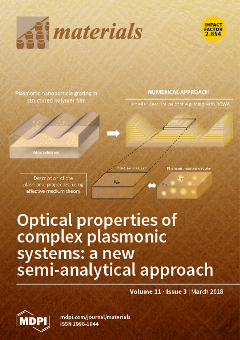The electronic, optical, and lattice dynamical properties of tetracalcium trialuminate (Ca
4Al
6O
13) with a special sodalite cage structure were calculated based on the density functional theory. Theoretical results show that Ca
4Al
6O
13 is ductile
[...] Read more.
The electronic, optical, and lattice dynamical properties of tetracalcium trialuminate (Ca
4Al
6O
13) with a special sodalite cage structure were calculated based on the density functional theory. Theoretical results show that Ca
4Al
6O
13 is ductile and weakly anisotropic. The calculated Young’s modulus and Poisson ratio are 34.18 GPa and 0.32, respectively. Ca
4Al
6O
13 is an indirect-gap semiconductor with a band gap of 5.41 eV. The top of the valence band derives from O 2
p states, and the bottom of conduction band consists of Ca 3
d states. Transitions from O 2
p, 2
s states to empty Ca 4
s, 3
d and Al 3
s, 3
p states constitute the major peaks of the imaginary part of the dielectric function. Ca
4Al
6O
13 is a good UV absorber for photoelectric devices due to the high absorption coefficient and low reflectivity. The lattice vibration analysis reveals that O atoms contribute to the high-frequency portions of the phonon spectra, while Ca and Al atoms make important contributions to the middle- and low-frequency portions. At the center of the first Brillouin zone, lattice vibrations include the Raman active modes (E, A
1), infrared active mode (T
2), and silentmodes (T
1, A
2). Typical atomic displacement patterns were also investigated to understand the vibration modes more intuitively.
Full article






